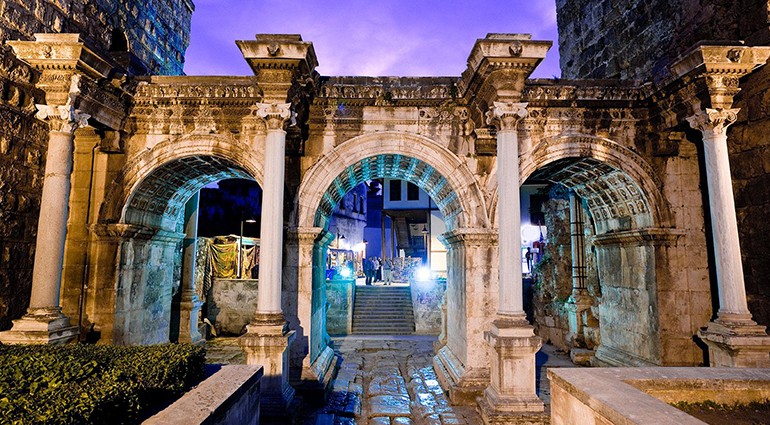A prominent symbol of the city in addition to the official symbol, the Yivli Minare, is Hadrian’s Gate which provides Antalya’s orientation in Roman times towards the important and nearest city in the region, Perge. The exterior of the structure formerly carried gold-plated letters of bronze in an inscription showing this gate was built to commemorate and to honor the Emperor, Hadrian, who visited the city on his tour of the Empire around 130 A.D. According to the information provided by the inscriptions on the south tower of the gate, it was constructed by Julia Sancta, a very wealthy and well-connected lady from Perge in the II c. A.D. and it has been kept its form as a Roman structure. It is evident the tower located to the North of the gate has been comprehensively repaired during the East Roman (Byzantine) and Seljuck periods. On both sides towers; standing upon on a high base is the composite single-storied gate, adorned with columns and with three approximately equal in size arches through the gate. Decorated on both faces with plant motifs, the vaults of the gateways have coffered slabs with floral rosettes. Original stone cladding which has partially survived on the structure; the pavement below the central arch carries the parallel depressions worn into the limestone paving through the wheeled traffic, loaded carts passing through this gate in antiquity pulled by draught animals, while the arches on either side were open to pedestrian traffic. After the strengthening of the defensive system of the city in the 10th century due to the increasing importance of the city and the external threats, this entrance to the city was walled up. The demolition of the city walls during the early 20th century, reorganized it as the main entrance and with excavation and restoration work carried out at the end of the 1950’s came the Hadrian's Gate of today and its surrounding environment. In addition to being a busy port of call for visitors to the city, an important part of the city’s culture heritage, it also forms an area for relaxation, reminiscence, meetings and conversations for the people of Antalya.
